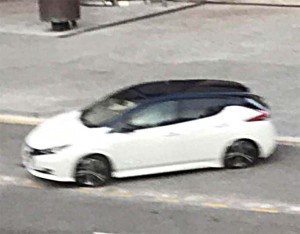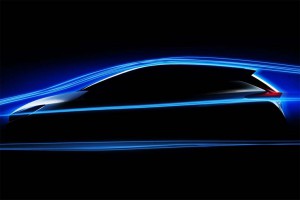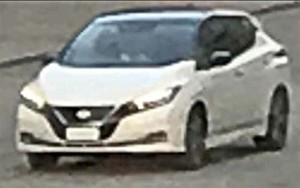With little more than a month to go before Nissan pulls the covers off its second-generation Leaf, what appear to be pictures of the battery-electric vehicle being shot for a promotional video have leaked out onto the web.
The Japanese automaker has already dropped some hints about the update, revealing that it will be the first of its products to get the semi-autonomous ProPilot Assist technology, as well as the drive-by-wire e-Pedal system which will effectively allow a motorist to use the throttle pedal to both accelerate and stop.
But the newly leaked images, on top of a company-released shot of the 2018 Nissan Leaf headlamps, indicate the new model will be far less quirky and distinctive than the original battery-electric vehicle. If anything, it will now look a lot more like the European subcompact, the Nissan Micra.
(Click Here for more on the new Nissan ProPilot Assist.)
The design of the original Nissan Leaf was intended to accomplish two goals:
-
Nissan wanted a look that was instantly recognizable as something high-tech and unique, much as Toyota had accomplished with its Prius hybrid;
- The Leaf also had to achieve maximum aerodynamic efficiency, as every “count” of wind resistance reduced its range, as well as performance.
Cheating the wind remains a critical goal for the Gen-2 Leaf, Nissan officials have stressed, but they seem to be less worried about going with a radical styling design that can attract some potential customers but alienate others.
The uncamouflaged vehicle caught in these shots by a read of Broom, an automotive publication by Norway’s TV2, might at first be dismissed as a variant of the Nissan Micra. But a closer look shows some details that reveal it to be the new Leaf. There are, for one thing, the headlights first seen in a handout image Nissan itself released to automotive journalists some weeks back. They frame a new front end featuring the latest version of Nissan’s V-Motion grille.
The “floating” black roof, meanwhile, borrows design cues seen on a number of recent Nissan models, including the sporty Maxima sedan, and it extends into color contrasting B- and C-pillars.
(Nissan offers tease of all-new ’18 Leaf EV. Click Here to check it out.)
The 2018 Nissan Leaf, overall, adopts a more crossover-like shape than the original model, something that should play better in a global market fascinated with SUVs and car-based CUVs.
Additional photos of the new Leaf are also starting to leak out from inside GM itself, someone calling himself BlueMiata on Twitter posting blurry images of the electric vehicle apparently rolling off the Nissan assembly plant in Opama, Japan.
“I work at a Nissan-related workplace. I discovered the new Leaf on the inspection line at the Opama plant,” the user wrote.
The design of the new Nissan Leaf has taken some industry observers by surprise, as it was widely expected to adopt the styling of the carmaker’s IDS concept vehicle.
How it will play out in the market is uncertain. Add all forms of battery-based vehicles, including conventional hybrids and more advanced plug-ins and BEVs and they currently add up to just 3% of the global new vehicle marketplace.
First introduced in 2010, the Leaf has been the world’s best-selling BEV since then, but it has been rapidly losing momentum as new, longer-range alternatives have come to market, starting with the Tesla Model S. Now, Tesla is offering the Model 3, which doubles the range of the first-generation Nissan Leaf, for a starting price of $35,000, roughly the same base price as Chevrolet’s own long-range Bolt EV.
Bolt has faced a tepid start-up, but Tesla has more orders than it knows what to do with, CEO Elon Musk suggesting last week that it will take until at least the end of 2018 – based on the company’s most optimistic production targets – to meet that demand.
Nissan hasn’t revealed much about the new Leaf, though recently retired corporate design chief Shiro Nakamura confirmed to TheDetroitBureau.com a goal of at least 200 miles per charge. Some reports indicate that will mean a 60 kilowatt-hour battery package, though a lower-range model with a more compact battery, may also be offered.
The new Leaf also will get such features as the ProPilot Assist, which is, essentially, a more advanced version of the Lane Keep Assist technology found on many of today’s vehicles. ProPilot won’t allow drivers to take their hands off the wheel for more than a couple seconds, unlike Tesla’s Autopilot.
The 2018 Nissan Leaf also will introduce e-Pedal. In most cases, explained Nissan, you’ll be able to operate the car – speeding up, slowing down, even coming to a stop in some circumstances – using just the throttle.
We’re expecting to get a better look at the new Leaf when it is officially uncovered on September 6th.
(For more on Nissan’s new e-Pedal, Click Here.)




